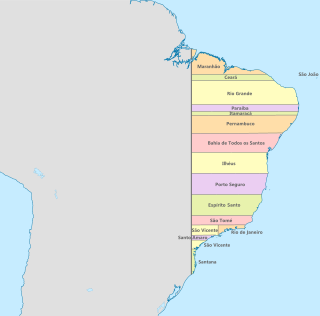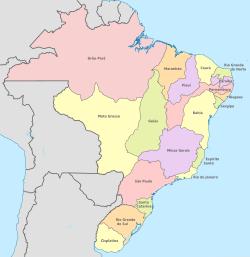
The federative units of Brazil are subnational entities with a certain degree of autonomy and endowed with their own government and constitution, which together form the Federative Republic of Brazil. There are 26 states and one federal district. The states are generally based on historical, conventional borders which have developed over time. The states are divided into municipalities, while the Federal District assumes the competences of both a state and a municipality.

The Captaincies of Brazil were captaincies of the Portuguese Empire, administrative divisions and hereditary fiefs of Portugal in the colony of Terra de Santa Cruz, later called Brazil, on the Atlantic coast of northeastern South America. Each was granted to a single donee, a Portuguese nobleman who was given the title captain General.

Futsal in Brazil is governed by the Brazilian Futsal Confederation. Although it is not the most popular spectator sport in the country, it is the most practiced.

The 2009 swine flu pandemic in Brazil began on April 25, 2009, with two people, spreading to 34 over the first two weeks. CDC calculate that Africa and Southeast Asia, which have 38% of the world's population, accounted for a disproportionate 51% of the deaths.

The State of Maranhão was the northern of two 17–18th century administrative divisions of the colonial Portuguese Empire in South America.

The Governorate General of Brazil was a colonial administration of the Portuguese Empire in present-day Brazil. A governorate was equivalent in status to a viceroyalty, though the title viceroy didn't come into use until the early 18th century. They were ruled by a Governor General who reported to the Crown. The Governor General had direct authority over the constituent royal captaincies, and nominal but ill-defined authority over the donatary captaincies. One captaincy, that of Duarte Coelho in Pernambuco, was exempt by royal decree from the authority of the Governors General.
The Miss Brazil 2014 was the 60th edition of the Miss Brazil pageant, held in Centro de Eventos do Ceará, Fortaleza, Ceará, Jakelyne Oliveira of Mato Grosso, crowned her successor Melissa Gurgel of Ceará. Delegates from each state and the Federal District for competed for the national crown. The winner represented Brazil in Miss Universe 2014 and placed Top 15.

Events in the year 2000 in Brazil.

Events in the year 1960 in Brazil.

Events in the year 1997 in Brazil.

Events in the year 1998 in Brazil.

Events in the year 1965 in Brazil.

Events in the year 1962 in Brazil.

Events in the year 1981 in Brazil.
Miss Brazil CNB 2017 was the 28th edition of the Miss Brazil CNB pageant and the 3rd under CNB Miss Brazil. The contest took place on August 12, 2017. Each state, the Federal District and various Insular Regions & Cities competed for the title. Beatrice Fontoura of Goiás crowned her successor, Gabrielle Vilela of Rio de Janeiro at the end of the contest. Vilela represented Brazil at Miss World 2017. The contest was held at the Hotel do Bosque in Angra dos Reis, Rio de Janeiro, Brazil.

Events in the year 2022 in Brazil.
Miss Brazil 1999 was the 45th edition of the Miss Brazil pageant. It was held on 8 April 1999 at Scala Rio in Rio de Janeiro, Rio de Janeiro State, Brazil and was hosted by Deise Nunes. Michella Marchi of Mato Grosso do Sul crowned her successor Renata Fan of Rio Grande do Sul at the end of the event. Fan represented Brazil at the Miss Universe 1999 pageant. 1st Runner-Up, Paula Carvalho of Rio de Janeiro, represented Brazil at Miss World 1999 and 2nd Runner-Up, Alessandra Nascimento of Minas Gerais, represented the country at Miss International 1999.

The Captaincy of Maranhão was one of the administrative subdivisions of the Brazilian territory during the colonial period in Portuguese America. It was created in 1534 along with thirteen other hereditary captaincies and granted by John III, King of Portugal, to the so-called donatários.












